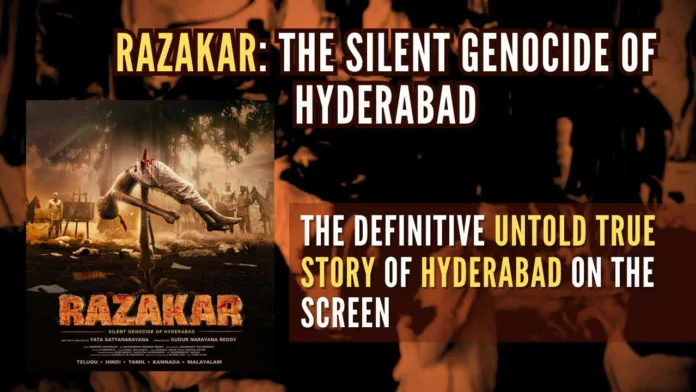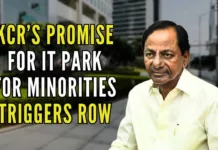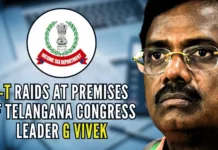
Razakar, an extraordinarily well-made movie
The historical movie `Razakar: The Silent Genocide of Hyderabad’ released in multiple languages, Telugu, Hindi, Kannada, Tamil, and Malayalam (to be released in Marathi too) is an honest and sensitive portrayal of many well-documented true incidents and events of the most brutal terror unleashed by the razakars in the then Hyderabad state before 1948; these brutalities are connected seamlessly and portrayed brilliantly in this extraordinarily well-made made movie. Sri Guduru Narayana Reddy’s moral courage and the Writer-Director Sri Yaata Satyanarayana’s visual narration and technical brilliance show up in every frame. The movie has excellent technical, production values, cinematography, and music. All the actors, portraying many protagonists, even actors playing smaller parts, are completely embedded in the perfect narration.
The movie is engrossing and knits together many brutal and cruel massacres of Hindus which occurred in various parts of the then Hyderabad State, in the regime of the last Nizam Osman Ali Khan. The then-Hyderabad state comprised ten districts of today’s Telangana, five districts of today’s Maharashtra, and three districts of today’s Karnataka, making it the largest princely state in British India. The fanatic jihadi razakars (armed Islamic militia numbering between 150000 – 200000), led by the Aligarh Muslim University educated Khasim Rizvi, who takes over the Majlis Ittehadul Musalmeen party, their ‘attack, murder, rape, loot and convert’ operations against the poor impoverished hapless people, in village after village, fully supported by the last Nizam, are picturized with great detail.
The movie takes a panoramic view and aptly juxtaposes the three main sets of players – the razakars and the spread of their terror with the active connivance of the last Nizam, the hapless Hindu victims of the jihadi regime, and lastly the political stakeholders in Delhi, especially the then Home Minister Sardar Patel and the Agent General of Hyderabad Sri KM Munshi.
The resistance and sacrifices of Arya Samaj, the role of the Congress party, Andhra Mahasabha, and that of the Communist Party are portrayed honestly giving due credit to the contributions of many. Many great freedom fighters like Arya Samajists, Narshimha Reddy, Raji Reddy, Narayan Rao Pawar, Shoibullah Khan, and many other heroic tales of great resistance are narrated. Many brutalities of infamy and ignominy are captured in the movie, including Bhairavunipalle, Parakala, Gorta, Chityala, the Bathukamma festival’s gruesome naked dance and massacres in Gandlapur near Wadi, etc.
The film has many moments– rousing, pathos, despondency, and despair, leading to the final denouement. There wouldn’t be an eye in the audience that hasn’t shed a tear or two.
All the ensemble cast including actors who play smaller parts, and hundreds of others who play the parts of villagers, look completely native and authentic, including their clothes and general ambiance, showing another facet of great casting, costumes, and directorial brilliance. The stellar cast plays their parts excellently, especially Raj Arjun playing Khasim Rizvi, Makarand Deshpande as the Nizam, Tej Sapru as Sardar Patel, T Vijay as KM Munshi, senior actresses Indraja as Chakali Ailamma, Prema, and Anasuya Bharadwaj as Pochamma and many others.
The film systematically chronicles the epic political events of 1946-48, Indian independence, Hyderabad Nizam’s intransigence of wanting to be an independent Islamic country in the heart of India, the Standstill agreement, Nizam transferring the looted riches abroad, Nizam reaching out to Pakistan and United Nations, Nehru’s apathy and Sardar Patel maneuvering and biding his time for the final action. The film steadily builds up the crescendo to move towards the exhilarating climax; Govt of India’s military action Operation Polo (13-17 September 1948) led by Major General J N Choudhuri, defeated Nizam’s formal army and the razakars led by Major General El Edroos; the Indian army thus liberated and merged the state of Hyderabad into the Indian Union. The military operations converging on Hyderabad City from all four sides, with thousands of ordinary people cooperating with the forces and welcoming them with flower petals are filmed exceptionally well.
It needs to be remembered that attempts were made by many to thwart the release of the film; an organization called the Association for Protection of Civil Rights (APCR), went to the Hyderabad High Court to prevent the release of the film on the grounds that it would disturb communal harmony. Thankfully the court threw out the petition. It was reported that the movie Producer Mr Narayana Reddy is being given police protection as he is constantly getting many threat calls.
In the now trendsetting ‘anti-propaganda’ movies, which have attempted to set the historical record straight, ‘Razakar’ will always remain unforgettable. The new-age filmmakers ushering in memorable films that boldly recount the long-suppressed truths owe an immeasurable debt to Shri Vivek Agnihotri, who has shaken the nation with his ‘The Kashmir Files’. Hopefully, many more such forgotten or suppressed stories will be made by courageous filmmakers.
(Tailpiece – it’s a tragedy of the Indian nation that Razvi was in jail for only seven years, and he and his family which comprised 10 children, were allowed to migrate to Pakistan in 1957. The Nizam was made Raj Pramukh in 1950 and lived in Hyderabad’s King Kothi palace in great splendor with multiple wives and hundreds of servants till his death. Though initially banned, the MIM was resurrected in 1957 and continues to be a major political force. The Communists continued their insurrection against the Indian Union till 1952).
Note:
1. Text in Blue points to additional data on the topic.
2. The views expressed here are those of the author and do not necessarily represent or reflect the views of PGurus.
For all the latest updates, download PGurus App.










